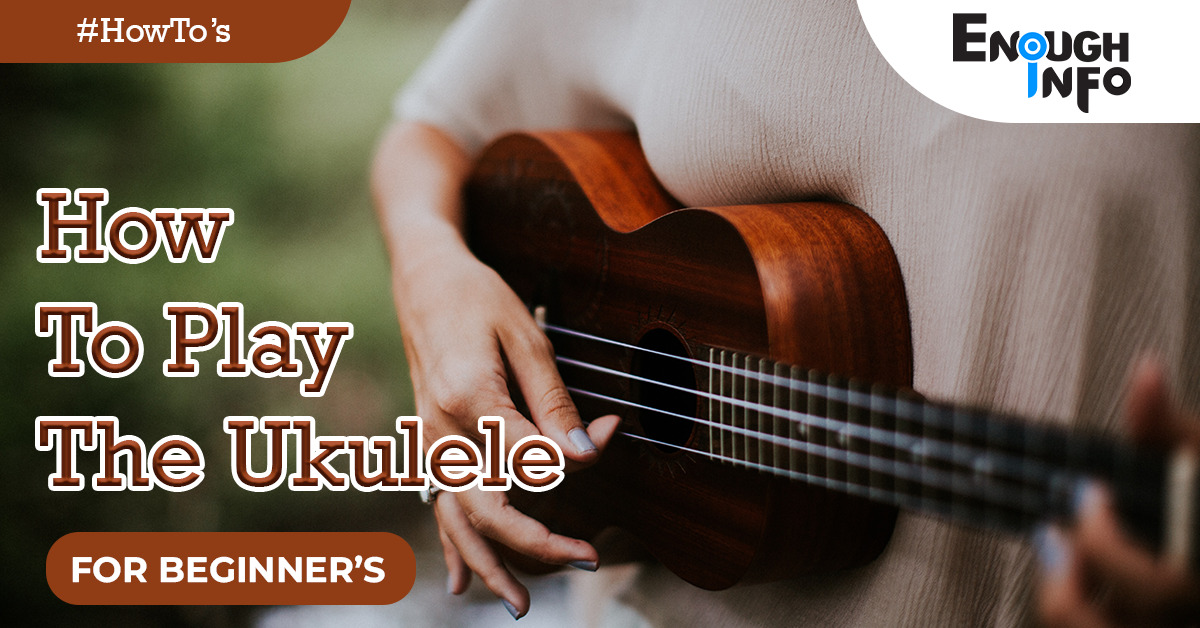
How To Play The Ukulele (For Beginners): The ukulele is a charming and accessible instrument, perfect for beginners who are eager to learn how to play music. Its small size and simple chord structures make it relatively easy to pick up, even for those with little to no musical experience. EnoughInfo.com

The ukulele is a social instrument, a song machine that attracts people together to have fun. Be careful: the ukulele vibe is quite contagious. Once you’ve mastered your first chords, strums, and tunes, you might be motivated to share them with a buddy.
Read Also: How to play guitar chords(All You Need To Know)
A Word About Hands & ‘Handedness’ on the Ukulele
Both hands have a lot of work to do! The chording hand is the one that holds down the strings, while the strumming or “speaking” hand is the other. The majority of people, including some lefties, strum with their right hands and chord with their left. However, some lefties find it difficult to articulate rhythm with their non-dominant hand. They have two options: spin it around and play it backwards, creating their own chord structures, or restring their instrument. Restringing is a simple process that can free a lefty from crippling frustration. For our purposes, I’ll call the strumming hand the right hand and the chording hand the left hand. In addition, chord diagrams are usually drawn in the traditional right-handed manner. If you’re a lefty who’s restrung, you undoubtedly know what to do: flip all diagrams and directions to the left. How to clean a microwave(The Ultimate Guide )
When the nails on the chording hand are cut very short, everything becomes considerably easier for all players. Longer nails on the strumming hand can be used as picks, or plectrums as they are known in British countries.
FAQs & Answers on How to play the Ukelele
1. How long does it take to learn to play the ukulele?
The time it takes to learn to play the ukulele varies depending on individual dedication, practice frequency, and musical background. With regular practice and commitment, beginners can start playing simple songs within a few weeks or months. However, mastering the ukulele is an ongoing process that can take years of practice and exploration.
2. Do I need to read sheet music to play the ukulele?
Reading sheet music is not a requirement for playing the ukulele, especially at the beginner level. Many ukulele players rely on chord charts, tablature, and online tutorials to learn songs. However, learning to read sheet music can be beneficial in the long run, as it opens up a wider range of musical resources and enables you to communicate with other musicians more effectively.
3. Can I learn to play the ukulele without a teacher?
Yes, it is possible to learn to play the ukulele without a teacher, especially with the abundance of online resources available. Online tutorials, video lessons, and instructional books can provide guidance and help you progress. However, having a teacher can offer personalized feedback, tailored lessons, and guidance on technique and musicality. It ultimately depends on your learning style and preferences. How To Organize Digital Files
4. What are some popular songs to learn on the ukulele?
There are numerous popular songs that can be played on the ukulele, catering to various musical tastes. Some beginner-friendly songs include “Riptide” by Vance Joy, “Hallelujah” by Leonard Cohen, “I’m Yours” by Jason Mraz, and “Somewhere Over the Rainbow” by Israel Kamakawiwo’ole. Explore different genres and find songs that resonate with you to keep your learning journey enjoyable.
5. Can children learn to play the ukulele?
Absolutely! The ukulele is a great instrument for children due to its smaller size and simplicity. Many children find the ukulele approachable and enjoyable to play. There are even ukulele models specifically designed for kids. With proper guidance, patience, and encouragement, children can learn to play the ukulele and develop a lifelong love for music.
Read Also: How to play the piano by ear(step-by-step guide)
How to Play The Ukulele for Beginners: A Step-by-Step Guide to Getting Started
In this step-by-step guide, we will walk you through the basics of playing the ukulele and help you get started on your musical journey.

Step 1: Choose the Right Ukulele
Before you begin playing, it’s important to choose the right ukulele for you. Ukuleles come in different sizes, including soprano, concert, tenor, and baritone. The soprano ukulele is the most common and suitable for beginners. Consider factors such as your budget, personal preference for tone and size, and the quality of the instrument. How To Do A Basic Car Maintenance Check
Step 2: Learn the Parts of the Ukulele
Familiarize yourself with the various parts of the ukulele. The main components include the body, neck, fretboard, strings, tuning pegs, and soundhole. Understanding the different parts will help you follow instructional materials and properly handle your instrument.
Step 3: Tune Your Ukulele
Tuning your ukulele is essential for producing pleasant sounds. The standard tuning for a ukulele is G-C-E-A, with the G string being the closest to your chest when holding the ukulele. You can use a digital tuner, a piano, or a tuning app to help you achieve the correct pitch for each string. How To Make A Compost Bin (The Ultimate Guide)
Step 4: Learn Basic Chords
Chords are the building blocks of music, and learning a few basic ones will allow you to play a variety of songs. Start with simple chords like C, F, G, and Am. Practice transitioning between these chords smoothly, paying attention to the placement of your fingers and the sound produced. There are numerous online resources and tutorials available that provide chord charts and finger placement guidance.
Read Also: How AI Voice Cloning Works And How To Use It
Step 5: Strumming Techniques
Developing strumming techniques is crucial for adding rhythm and melody to your playing. Start with basic downstrokes, using your thumb or a felt pick to strum across the strings. As you become more comfortable, experiment with different strumming patterns, such as upstrokes, fingerpicking, and rhythmic variations. Practice strumming along with simple songs or backing tracks to improve your timing and coordination.
Step 6: Learn Basic Music Theory
While not mandatory, learning some basic music theory will greatly enhance your understanding of the ukulele and music as a whole. Familiarize yourself with concepts like scales, intervals, and key signatures. This knowledge will help you understand chord progressions, create your own melodies, and communicate with other musicians. How To Knit A Scarf (For Beginners)
Step 7: Practice, Practice, Practice
Consistent practice is key to improving your ukulele skills. Set aside regular practice sessions and commit to them. Start with short practice sessions and gradually increase the duration as you progress. Focus on playing chord progressions, strumming patterns, and songs that you enjoy. Remember to start slowly and gradually build up speed and accuracy.
Step 8: Expand Your Repertoire
As you gain confidence and proficiency, start expanding your repertoire by learning new chords, exploring different musical genres, and tackling more complex songs. Explore online tutorials, songbooks, and ukulele communities for inspiration and guidance. Don’t be afraid to challenge yourself and experiment with new techniques and styles.
Step 9: Play with Others
Playing with fellow musicians or joining a ukulele group can be a fun and rewarding experience. Seek out local jam sessions, open mic nights, or online communities where you can connect with How To Create A Podcast (All you need to Know)
other ukulele players. Collaborating with others not only allows you to learn from different playing styles and techniques but also provides an opportunity to develop your musicality and performance skills.
Read Also: How To Be Better At Something
Step 10: Enjoy the Process
Remember that learning to play the ukulele is a journey, and it’s important to enjoy the process along the way. Celebrate your progress, embrace challenges as learning opportunities, and find joy in the music you create. Don’t be too hard on yourself and allow yourself to make mistakes – they are a natural part of the learning process.
Why should you learn to play the ukulele?
Take a look at the ukulele. There’s a reason it’s a favorite instrument of so many performers, from George Harrison to Elvis Presley to Taylor Swift. Expert ukulele player Abe Lagrimas Jr. talks down some of the surprising methods and songs you can play on the ukulele in the “Why You Should Play Ukulele” edition of Fender Play LIVE!
Reasons to learn to play the ukulele include:
- It’s entertaining and simple to learn : Consider the ukulele to be a “fun-sized” instrument. Its modest size makes learning to play simpler for younger players and those with smaller hands. Even better, the ukulele is available in a variety of sizes, from the tiny soprano ukulele to the slightly bigger tenor uke, providing players more possibilities for finding the proper fit.
- It’s inexpensive: A new ukulele may be purchased for as little as $100 – and sometimes much less!
- Ukulele abilities transfer to guitar: While the strings on the ukulele are slightly different (more on that later! ), many of the chords and abilities you learn on the ukulele can be transferred to the guitar.
- You’ll be among friends: When you learn to play the ukulele, you’ll join the ranks of many others who like its carefree tone. There are numerous musicians who are good ukulele players, ranging from Billie Eillish to Grace VanderWaal. Artists like as Jake Shimabukuro and Israel Kamakawiwo’ole are well-known for their abilities and have elevated the ukulele to new heights. Furthermore, musicians such as Taylor Swift and The Who’s guitar maestro Pete Townshend have been known to pick up the ukulele and pluck a few chords. How To Meditate For Beginners
CAN I LEARN TO PLAY THE UKULELE ON MY OWN?
While you may undoubtedly teach yourself to play the ukulele, it can occasionally be beneficial to seek professional assistance to improve your skills. This page contains ukulele playing tips, tried-and-true strategies used by seasoned artists, and more information to help you play better faster.
Do you want video lessons that go deeper and show you how to play the ukulele? Fender Play provides bite-sized lessons from world-class educators whenever and wherever you want to learn more. Fender Play provides self-paced ukulele lessons that allow you to measure your progress, build on the abilities you acquire, and put those skills into practice by playing chords and tunes on ukulele.
Read Also: How to have a good singing voice (Top 14 Tips)
SELECTING THE UKELELE
Choosing a ukulele might be a daunting task. There are numerous sizes and types to select from, not to mention that each has a distinct tone. Here are a few pointers to consider while selecting a ukulele to help you limit down your options.
Size and Tone:
Ukuleles exist in a number of sizes, each with its own characteristic tone:
Soprano: This is the smallest ukulele size. When compared to their larger brethren, soprano ukuleles have a higher, lyrical tone. Their compact size and closer-spaced frets make them excellent for young beginners or players with small hands.
Concert ukuleles: These are larger than soprano ukuleles but remain small in size. They have more frets and a warmer, deeper tone than soprano ukuleles. How To Make Cold Brew Coffee (Step by step)
Tenor: The largest of the most popular ukulele sizes, tenor ukuleles offer a deep tone and are best suited to players with larger hands. The neck is slightly larger and heavier than the Soprano and Concert ukuleles, giving it a bassier tone than the concert and soprano ukuleles.
Holding the Ukulele
Begin your musical adventure by learning how to hold your ukulele. A significant amount of time is spent in the Suzuki violin technique studying the right manner to hold the instrument and bow. Children start with a box and a stick until the teacher determines that they are ready for the real thing. Although the uke is considerably more forgiving, it is crucial to strive for good technique from the start. A little attentiveness at first means you won’t have to unlearn negative habits later, and it may keep your tendons from straining. How To Paint A Watercolor Landscape
The instrument should be held close to your body, whether standing or seated. Many individuals use a strap to hold their instrument in the best possible position, but others do not. Without a strap, the instrument is held against the chest by the right forearm. For the time being, hold the neck loosely where it meets the headstock with your left hand. If you must sit, choose a chair with no arms. Slumping back will make things more difficult, so sit on the edge of your seat until you are a confident player. Cross your right leg over your left and softly place it against your thigh. Allow your shoulders to release tension. Remember to take deep breaths!
Your First Chord & Thumb Strum
Place your fingers between the frets, gently arching each one, and your thumb on the back of the neck, opposite your index finger.
From top to bottom, the strings are numbered 4-3-2-1. Stroke the strings gently with the pad of your thumb, one at a time. Anywhere you feel at ease strumming is acceptable, but the ideal spot is just where the neck meets the body. Sing along with the string numbers (4-3-2-1) and pitches (G C E A). Play them again while repeating the lines to the iconic ukulele tune, “My Dog Has Fleas!”
It has a pleasant, mellow tone. Strumming all four strings at the same time while counting a steady rhythm: 1-2-3-4, 1-2-3-4…. Sing the tune “Row, Row, Row Your Boat” as you strumming. (Hint: the first note is C if you’re having trouble finding it. Pluck the third string to assist you in getting started. Remember to count your strings starting at the bottom and working your way up!) Your strum will evolve through time to include other fingers and patterns, but steady, rhythmic down strokes are the foundation.
When you strum all of the open strings simultaneously, you create a chord called C6. The notes G C E A make up the C6 chord. Does this sound familiar? Those are the notes to which we tune our ukuleles! “C tuning” is the most popular method of tuning a ukulele. (You may discover antique texts that ask you to tune lower, to Bb tuning, whereas in Canada, many people tune higher, to D. C tuning is typically used in music found online and in modern books.) This chord is made up of all “open” strings, which means the left hand is not chording.
Read Also: How To Create A Podcast (All you need to Know)
Conclusion
Learning to play the ukulele is an exciting and fulfilling endeavor. By following these steps, you can get started on your ukulele journey with confidence. Remember to choose the right instrument, learn basic chords, develop strumming techniques, practice consistently, and enjoy the process. With time and dedication, you’ll find yourself playing your favorite songs and exploring the boundless possibilities of the ukulele. So grab your ukulele, strum away, and let the music fill your heart and soul.
Recommended;
11 Ways To Relax At Work( All You Need To Know)
How To Deal With Stress(Guide2023)
How to Stay Focused (Steps and Requirements)




